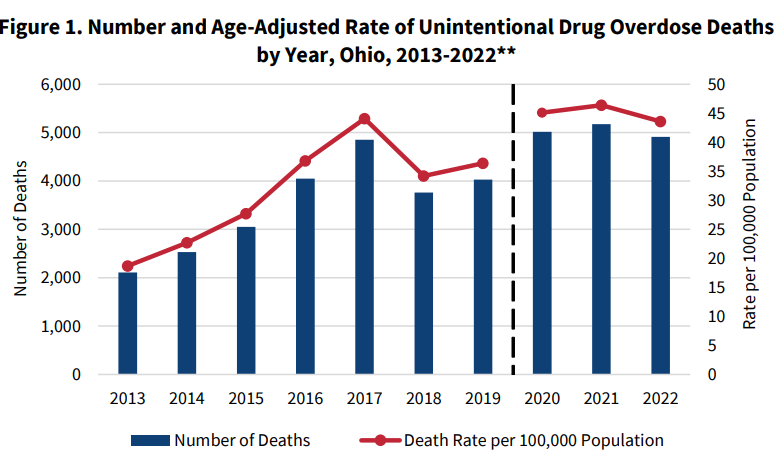Overdose deaths drop in Ohio, but increase in Stark County. Why?

- Oops!Something went wrong.Please try again later.
The number of overdose deaths in Stark County rose 11% last year, while Ohio saw a 5% decrease.
The jump in Stark also far exceeded the national increase of 1%.
According to the Stark County Health Department's annual overdose report, 159 people died from unintentional overdoses last year ― 134 of whom were county residents. Deaths have been on the rise since 2018, with 143 overdose deaths in 2021 ― 131 were Stark County residents.
Justina Gorman, coalition and community development coordinator at Stark County Mental Health & Addiction Recovery, said the "why" is difficult to answer.
"It's a lot of things," she said. "There's still a lot of stigma around getting access to resources, just substances being kind of pervasive in our culture."
Addiction is a "complicated brain disease," Gorman added, which takes a community effort to overcome.
The county's annual report showed that the most overdose deaths were among white men between the ages of 35 to 44 but when examining death rates by race, Black people had "significantly high" overdose deaths. The Black population had 61.82 deaths per 100,000 people and the white population had 36.38 deaths per 100,000 people last year.
Overdose deaths: 'You started seeing people drop dead': Overdoses strike Stark County's Black community
Opiates, fentanyl and fentanyl analogues (or derivatives) were the top drugs in unintentional overdose death in Stark County last year. Methamphetamine and cocaine were the fourth and fifth most common drugs, and more than 40% of overdose deaths involved a combination of opiates and stimulants.
Statewide, the number of Ohioans who died from unintentional drug overdoses dropped 5% last year, according to a report released by the Ohio Department of Health. There were 4,915 unintentional drug overdoses last year, a drop from the state's 2021 record of 5,174.
“While the numbers headed in the right direction last year, they are no cause for celebration,” said Dr. Bruce Vanderhoff, the department's director. “Tragically, thousands of Ohioans are still dying from substance use disorders. I urge Ohioans to do what they can to prevent these deaths, from learning how to use naloxone to knowing where to turn for help for you or a loved one in need."
In addition to the drop in unintentional drug overdoses, the Ohio Department of Health report highlighted:
Fentanyl and fentanyl variants were involved in 81% of unintentional drug overdose deaths in Ohio, often in combination with other drugs.
Heroin overdose deaths from 2021 to 2022 had the largest decrease at 43%
From 2021 to 2022, unintentional drug overdose deaths involving stimulant drug categories had the largest increases
Read more: 'You started seeing people drop dead': Overdoses strike Stark County's Black community
Report follows $100 million pledge to fight opioid addiction
ODH's report arrives on the heels of Gov. DeWine's announcement of $100 million in federal State Opioid and Stimulant Response (SOS) funding to continue to fight opioid addiction and prevent overdose deaths. The funding from the Substance Abuse and Mental Health Services Administration will "strengthen and sustain an array of prevention, harm reduction, treatment, and long-term recovery supports for Ohioans struggling with an opioid or stimulant use disorder."
More than $58 million of that $100 million is earmarked for Ohio's Alcohol, Drug Addiction and Mental Health Services (ADAMHS) boards spread out across 50 counties in the state. The funds will be used to expand access to local prevention, harm reduction, treatment, and recovery support, officials said.
Another $16.6 million will be used for community initiatives, including for partnerships with the Ohio Department of Health, to purchase more of the overdose reversal drug naloxone, and to provide services to the Ohio Department of Veteran Services for veterans and active-duty service members struggling with opioid and stimulant use disorder.
Stark County will receive $343,970 in SOS funding for the Sept. 30, 2023, to Sept. 29, 2024, period.
Gorman said StarkMHAR partners with Stark County Treatment Accountability for Safer Communities (TASC) to provide services with the funding, which they've received annually for at least five years. TASC offers peer support in emergency departments and other facilities to help connect people to treatment resources.
Read more: As opioid deaths continue, national study brings resources to Stark to learn what saves lives
StarkMHAR also recently took part in the HEALing Communities Study led by the National Institutes of Health, which granted $731,899 to local interventions from July 2022 to December 2023. Gorman said efforts included community awareness, such as encouraging people to carry naloxone, and the Stark County "health mobile" that started in May and will continue after a short hiatus.
"Its goal was to do overdose education and naloxone distribution and also serve as linkage to medication for opioid use disorder," she said.
Help is available
Naloxone, a medication that can reverse opioid overdoses commonly sold under the brand name Narcan, is free and available to Stark County residents without a prescription.
"I would absolutely encourage every single person to carry naloxone," Gorman said. "It's an easily accessible nasal spray, so no worries about injections."
Health departments and providers typically carry it, and there are three vending machines outside of Refuge of Hope in Canton, Massillon Health Department and Alliance Commons. Canton City Public Health also offers a mail-order form for Stark County residents.
Gorman said signs of an opioid overdose include: A person who is pale and clammy, has purple or blue lips or fingernails, is making gurgling or snoring sounds, and can't be woken. If it's not clear whether someone is having an overdose, administering naloxone should not have a negative effect.
Stark MHAR also operates a 24-hour opioid hotline at 330-454-4357. Additional Stark County resources can be found at savestark-starkcohealthoh.hub.arcgis.com.
@ShahidMeighan
smeighan@dispatch.com
This article originally appeared on The Columbus Dispatch: Drug overdoses increase in Stark County in 2022, but fall statewide

